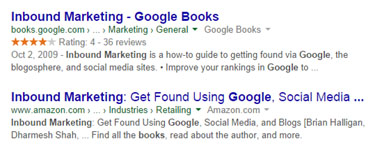Schema is a semantic vocabulary of tags (or Microdata) that you can add to your HTML to improve the way search engines read and represent your page in SERPs.
Schema (or Schema.org) is the result of collaboration between Google, Bing, Yandex, and Yahoo! to help you provide the information their search engines need to understand your content.
Adding Schema Markup (or Structured Data) to your HTML improves the way your page displays in SERPs by enhancing the rich snippets that are displayed beneath the page title.

For example, the first search result above contains both a star rating and a publication date. Both of these can be added using Schema. The second example does not have rich snippets and instead displays either the meta description or other information chosen by Google.
Your web pages have an underlying meaning that people understand when they read the web pages. But search engines have a limited understanding of what is being discussed on those pages. By adding additional tags to the HTML of your web pages—tags that say, “Hey search engine, this information describes this specific movie, or place, or person, or video”—you can help search engines and other applications better understand your content and display it in a useful, relevant way. Microdata is a set of tags, introduced with HTML5, that allows you to do this.
The difference between Schema, Microdata, and Structured Data:
Structured data is a system of pairing a name with a value that helps search engines categorize and index your content. Microdata is one form of structured data that works with HTML5. Schema.org is a project that provides a particular set of agreed-upon definitions for microdata tags.
Types of items described by Schema:
Structured data can be used to mark up all kinds of items from products to events to recipes. It is most often used to provide additional information about the following:
- Event
- Organization
- Person
- Place
- Product
- Articles
- Book Review
- Local Business
- Movies
- Restaurants
The most common schema terms:
i) itemscope: This is one of the most common schema terms. It essentially organizes your content by topic. More specifically, it tells search engines that all of the content marked with an itemscope tag is about the same topic. Think of it as categorizing your content into different sections.

You can make one tiny change to let search engines know that all of this info is about the same topic. Simply include “itemscope” at the end of your opening <div> tag, like this:

ii) itemtype: The itemtype term further categorizes your content. The itemscope term told search engines that your content was about an item, and the itemtype term will tell search engines what kind of item your content is about.
In this example, the itemtype markup would look like this:

This will tell search engines that all of the content between the <div> tags is about one movie.
iii) itemprop: This term lets you define certain properties that your items have. Basically, the itemprop term is communicating additional information about the item. There are countless types of itemprops you can assign. For our example, here are some possible itemprop types:

By using all of these terms, you’re going into extreme detail, which is a good thing. That means search engines can more easily and more accurately organize your content.
Adding structured data to your site:
I’ll cover two of the best ways to implement schema:
- Using WordPress plug-ins
- Google’s Structured Data Markup Helper
What is the benefit of using structured data?
It can help you enhance the presentation of your listings in the SERPS either through featured snippets, knowledge graph entries, etc and increase your CTR.






























Add comment